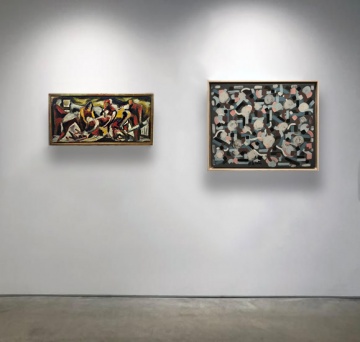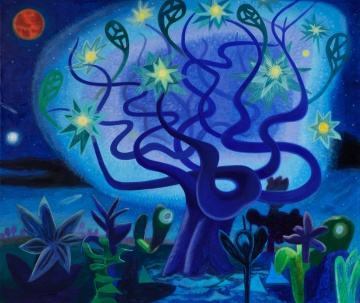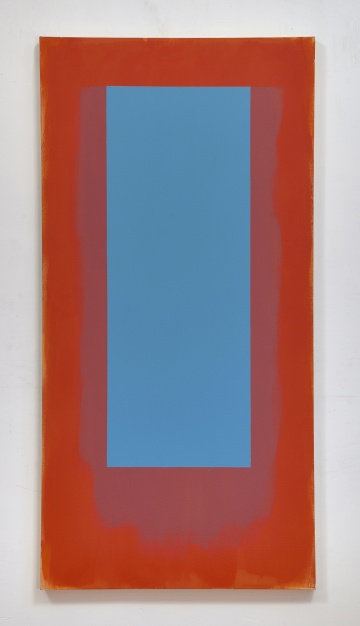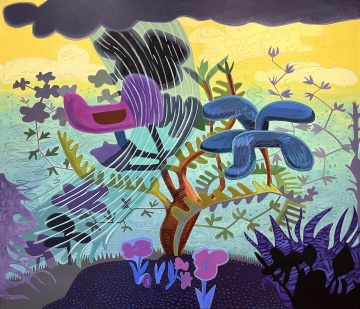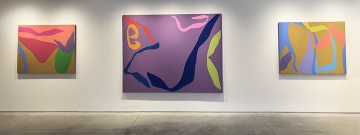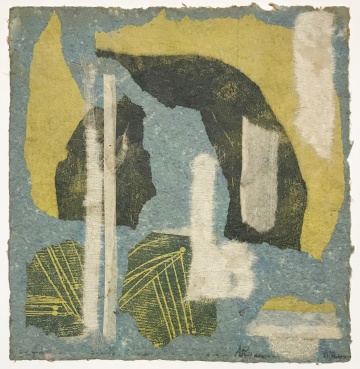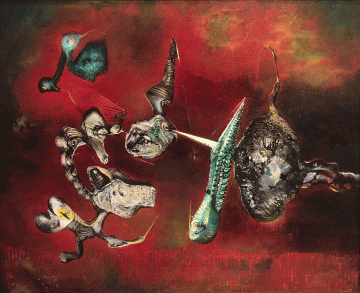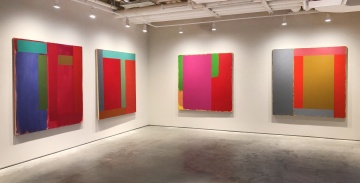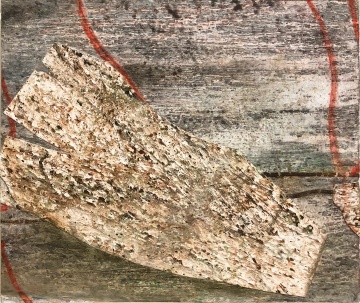Washburn Gallery
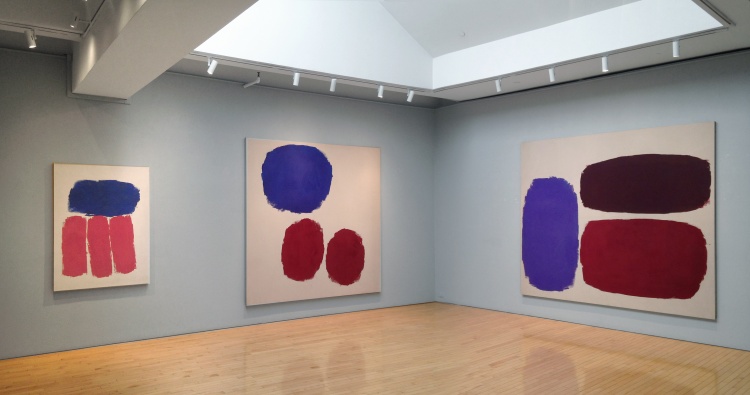
Installation view. Courtesy of Washburn Gallery.
JoAnne Carson
JoAnne Carson: Under the Stars
September 8, 2023 - October 14, 2023
JoAnne Carson has said, “Disrupting illusion is in my blood.” [Bomb Magazine, "Free Spirits: JoAnne Carson interviewed by David Shapiro,” July 7, 2022]
She was partly acknowledging Mark Rothko, to whom Carson’s mother had been married in the late 1930s. A few early Rothko’s, elusive and surrealist, presided over Carson’s childhood. But she was mostly speaking about her own enormously productive and inventive body of paintings, sculptures and hybrids, all of which play fast and loose with representation. Carson’s most recent paintings, however, have been doing their disrupting with more nuance and subterfuge. A newly legible grammar of light and space puts Carson’s deftly synthetic, retro-Pixar color at center stage. Seductive and sure-footed, these quasi-illusionistic landscapes have become, paradoxically, as moody and numinous as the most ambitious abstraction.
This notable uptick in Carson’s practice, not only in terms of quality but quantity, was hard-won, and involves a kind of backward trajectory through art history by way of animation. Her paintings of the previous decade tended to be more angular and anarchic, along the lines of the zippy, hand-me-down modernism of 60s budget cartoons. In recent mashups on view such as Updraft and Cloudburst (both 2022) one can still trace the rogue lineage of, say, Rocky and Bullwinkle and the Hawaiian Punch ads — a manic vein pioneered, in part, by Elizabeth Murray and still mined by contrarian contemporaries such as Carroll Dunham and Joanne Greenbaum.
But Carson’s mises-en-scene have been getting more enchanting, more cunning. The magical moonlit aura of Day for Night, or the firefly phosphorescence of Mars Rising (both 2023) are exemplars of a calm, coherent new mastery that hints at the mystical visions of desert transcendentalists like Agnes Pelton or Raymond Jonson, but by way of the crisp, pastel elegance of 50’s Disney classics such as Peter Pan and Alice in Wonderland. (Carson is an avowed fan of Mary Blair, who contributed sophisticated concept art for those films.)
“Know-how apotheosized,” as Peter Schjeldahl described the Disney dream factory, doesn’t grow on trees [Peter Schjeldahl, “Disney Animators,” 1981, collected in The Hydrogen Jukebox, 1991, University of California Press, p. 94]. Carson, having survived in 2018 the kind of medical emergency that tends to concentrate the mind, decided thereafter to devote herself to painting rather than cycle back and forth with sculpture as had been her custom. Or rather, she absorbed the step-by-step pragmatism of the sculptor (and for that matter, the animator) into a radically traditional painting practice designed to cut to the chase. Now she begins with freely sketched, but solidly germinative drawings. From these she makes thorough, energetic color studies using acrylic, collage and Photoshop before embarking on a final painting. As she put it in a recent interview:
"I realized I was too attached to the drama of problem solving, the not knowing. I could swap that out with resourcefulness. I could solve some of the problems I was having while preserving the problem." [Bomb Magazine, "Free Spirits: JoAnne Carson interviewed by David Shapiro,” July 7, 2022]
Carson often exhibits all three stages — drawing, collage, painting — as independent artworks, but rarely in complete progressions that allow us to follow along, as here in a couple of instructive cases. Thus, the drawing Young Love (2022) works out the anatomy of a knobby, contrapposto tree with vivid amputations and a jutting growth that suggests a woody version of a toddler’s toy, as well as distant hills and sidekick flower stalks, all of which will persist faithfully in subsequent elaborations. Other parts of the drawing are rich with erasure and provisional gestures, suggesting a cloud of possibilities — in particular a swooping rush of charcoal that the collage Punch Drunk Love (2022) realizes as a purple sunshower woven like a magic carpet in and out of space. The collage adds, aside from the inflationary universe of color, much botanically wanton complexity to the top branches of the tree while emphatically sculpting, one could almost say, trunk and plasticized flower petals in graphically arresting patches of saturated pigment. Finally, the painting Lovestruck (2023) replaces the sunshower with the backlit glow of dusk, and everywhere articulates detail with translucent, luminous tissues of color that ripen this impossible yet serene composition into a goofball Bellini.
Likewise, viable stations along the way have led to each of these fascinating, gorgeous, and quite moving paintings, all with the theme of a central tree-of-plenty — an ever renewable protagonist set in a responsive panorama of cosmic harmony. Carson has found not only her method but her subject. And more than ever, her mojo.
DAVID BRODY, 2023
David Brody is a painter, animator and writer based in Brooklyn
Christopher Benson
Christopher Benson: Recent Paintings
June 1, 2023 - July 28, 2023
On Painting in the American West
A life-long realist and figurative painter, Christopher Benson has also been painting abstract and expressionistic pieces "on the side" since his student days in the early 1980s. Though he has occasionally exhibited this work, it has only recently become the focus of a now 40-year exhibition career spanning both coasts of the US and the spine of the country from the desert southwest to the great plains of the Dakotas. After a retrospective museum exhibition of his realist work in 2017, Benson began to bring his more non-objective alter ego to the forefront, while searching for ways to blend these two long, formerly-parallel lines of his interest together.
In an essay published last fall in the book ART IN THE MAKING, Essays by Artists About What They Do, Benson writes the following about this more abstracted and expressionistic strain of his work:
"I have always had a "painterly" approach, with brush and knife marks clearly evident in the surfaces of my pictures. It's challenging though to find a physical abstraction which doesn't just recycle the big gestures of the New York School, or call up the ubiquitous handmade vocabularies of Bay Area painters like Park and Diebenkorn. I love that lineage, and it is clearly where my work comes from, but I have also worked to build a vocabulary of my own that looks in a different direction while yet acknowledging those roots.
American painting has long been stuck in a project of self-mythologizing, and the desert southwest, where I live, has been an especially myth-making place for American painters. One immediately thinks of Georgia O'Keeffe or Agnes Martin as the iconic voices of the great and mystical desert. The reality of the southwest however is that it is a far less epic, much funnier, more broken and deeply, stubbornly eccentric place than such lofty visions might suggest.
The artist who drew me to New Mexico when I first drove west in a Chevy van at age twenty-eight, was George Herriman, the cartoonist of the quirky, irreverent Crazy Kat comic strips of the 1930s. Herriman set his oddball characters in an imaginary expanse of tilting prairies, studded with small, alien trees and with implausibly anthropomorphic rock formations jutting into black or cobalt skies, dotted with merengues and zeppelins of cumulous cloud. For all its implied hugeness, Herriman's desert was also a miniature, vulnerable and profoundly human place.
As we devour and destroy the natural world at every turn, and become ever more entrenched into inflexibly self-righteous cantons of ideology, I see the vulnerability, eccentricity and humor of Herriman's art as a guidepost for my own American painting. You can have the great lions of modernism; I'll take the lovelorn Kat and the angry, brick-throwing mouse, whose fragile, magical landscape was always poised at the very end of the American Dream."
— Christopher Benson, 2023
All in Together
March 30, 2023 - May 27, 2023
The Washburn Gallery unites in one room a selection of paintings, sculpture, collages and works on paper by eleven artists - all in together.

MOSAIC
November 10, 2022 - January 21, 2023
Alice Trumbull Mason
Shutter Paintings
November 4, 2021 - January 22, 2022
With the “Shutter” paintings, Alice Trumbull Mason pushed her personal take on modernism to a new limit. They are a departure from her signature biomorphic or neo-plastic compositions. The works stand out, striking in their simplicity and confidence. Perspectival depth is almost completely gone. Volumes have disappeared. More than a decade earlier, in 1948, Mason had formulated a concept of “displacement” for a series of paintings all titled with “Bearings.” This is what she writes: “One theme is that of displacement of one form by another, every space in the painting being regarded as a separate form working in conjunction with all the others. Dis-placement should be understood in contradistinction to the idea of representing perspective on a two-dimensional plane. Displacement occurs through the juxtaposition of colors and through formal construction, that is, one form does not stand in front of another but displaces it with color and form.” [Ray Bethers, Alice Trumbull Mason, 1948, 246]
The “Shutter” paintings embrace fully this displacement concept. Mason lines up forms at the very edge of the pictorial surface. Each depends on and influences the next. They look like pali-sades. They have breadth, one could say magnitude, a word the artist used to title the paint-ings: Ionic Magnitude, 1960, Magnitude of Memory, 1962 etc. Mason favors blues, greys, or-anges, and blacks. They are moody: from a pale light to deep melancholy. With one exception there are no shadows. The vertical forms succeed each other with irregularity. The works are neither cold nor anonymous in their handling of paint. Brush marks are visible, Mason varies the density of paint, and the traces of process remain. Some corners are filled with tactile marks. Edges are slanted rather than straight. They are hard-edge, minimal but clearly hand-made. They are a testament to Mason’s singular approach.
- D. Barbara Stehle, 2021
Enrico Donati
Enrico Donati: Surrealist Paintings from the 1940s
April 8, 2021 - July 30, 2021
“Enrico Donati: Surrealist Paintings from the 1940s” at the Washburn Gallery is the first major exhibition of the artist’s work in New York in over two decades. Twelve paintings from 1942-1947 will be on view in person in the gallery and online from April 8 to July 30, 2021.
Born in Milano, Italy in 1909, Enrico Donati is largely remembered as a Surrealist painter despite his brief affiliation with the movement. Donati spent most of the 1930s in Paris, but it was in New York where he was brought into the fold of the Surrealist circle. Marcel Duchamp, Andre Breton, and Yves Tanguy – to name only a few – were among the distinguished artists who also fled to New York from Europe with the threat of war and Nazism. After taking refuge in New York from Paris in 1940, Enrico Donati’s first solo show, held in 1943 at the New School, led to the artist’s connection to Surrealism when his work captured the attention of Andre Breton. In the 1944 preface to the catalogue for Enrico Donati’s exhibition at the Passedoit Gallery, Breton positions the artist’s work as the linchpin between abstraction and figuration, thus healing a fracture in the Surrealist movement.
Doug Ohlson
Doug Ohlson: Paintings from the 1980s
February 4, 2021 - April 3, 2021
“Ohlson’s control of color, arrived at by intuition rather than scientific theory, is always part and parcel with the compositional means he has selected at each stage of his evolution. These developments as outlined here may sound more methodical, more plotted than they actually have been. Neither he nor any other good artist educates himself to produce some final revelation of an earlier vision. Quite oppositely, at each stage the paintings have spoken for themselves on the premises which underlay their making at the time. Yet it is impossible in retrospect not to see that his preoccupations have contributed to an ongoing process and continuity.”
- E.C. Goossen
Excerpt from the essay for the exhibition
"Doug Ohlson at Bennington: Two Decades, 1962-1982," Bennington College, VT, 1982
DOUG OHLSON
Born: November 18, 1936; Cherokee, Iowa
Died: June 29, 2010; New York
Solo Exhibitions from the 1980s
1982 Bennington College, Vermont; curated by E.C. Goossen; “Doug Ohlson at Bennington: Two Decades, 1962-1982”
1985 Andre Zarre Gallery, New York, also 1990-95, 2000, and 2004
Ruth Siegel Ltd, New York
1986 Galerie 99, Bay Harbor Islands, Florida
Nina Freudenheim Gallery, Buffalo, New York
1987 Ruth Siegel Ltd., New York; "Four Painters in New York - Four Solo Exhibitions: Leon Polk Smith, Doug Ohlson, Katherine Porter, Willy Heeks"
1989 Ann Jaffe Gallery, Bay Harbor Islands, Florida
Selected Group Exhibitions from the 1980s
1980 "Arte Americana Contemporanea", Civici Musei e Gallerie di Storia e Arte, Udine, Italy
1984 "24 x 24 x 24, An invitational exhibition", Ruth Siegel Ltd, New York
1985 "Bilder fur Frankfurt", Museum fur Moderne Kunst, Frankfurt, Germany
"The Severe and the Romantic: Geometric Humanism in American Painting, the 1950's
and the 1980's", Marilyn Pearl Gallery, New York
1986 "Harvest", Ruth Siegel Ltd, New York
"Square and . . .", Ruth Siegel Ltd, New York
"Ten Artists", Ruth Siegel Ltd at The International Contemporary Art Fair,
Los Angeles Convention Center, Los Angeles, California
1987 "Review / Preview", Ruth Siegel Ltd, New York
"Color Now", 55 Mercer Street, New York
1988 "20th Anniversary Group Exhibition", Paula Cooper Gallery, New York
1989 "A Debate on Abstraction: The Persistence of Painting,” The Bertha and Karl Leubsdorf Art Gallery, Hunter College, New York
"Small Paintings", Nina Freudenheim Gallery, Buffalo, New York
Selected Public Collections
Bowdoin College Museum of Art, Brunswick
Brooklyn Museum, New York
Dallas Museum of Art, Texas
The Metropolitan Museum of Art, New York
The Minneapolis Institute of the Arts, Minnesota
The Museum of Contemporary Art, Helsinki, Finland
Museum of Fine Arts, Boston
Museum fur Moderne Kunst, Frankfurt, Germany
The National Gallery of Art, Washington, DC
The University of Iowa Museum of Art, Iowa City
Utah Museum of Fine Arts, University of Utah, Salt Lake City
Weatherspoon Art Gallery, University of North Carolina, Greensboro
Albright-Knox Gallery, Buffalo
Lowe Art Museum, Miami
Karl Ernst Osthaus-Musuem, Hagen, Germany
Harvard Art Museum, Cambridge
Whitney Museum of American Art, New York
Palm Springs Art Museum
The Los Angeles County Museum of Art
Alice Trumbull Mason
Alice Trumbull Mason: A Pioneer of Abstraction
March 19, 2020 - April 25, 2020
Richard Stankiewicz
The Art Show 2020
February 25, 2020 - March 1, 2020
This year the Washburn Gallery will be exhibiting works on paper and sculpture by the artist Richard Stankiewicz.. Although known as a sculptor we will install 15 of his sumi ink drawings on Japanese rice paper executed on a single day in November 1960. A sculpture from 1958 will also be included in the Washburn booth.
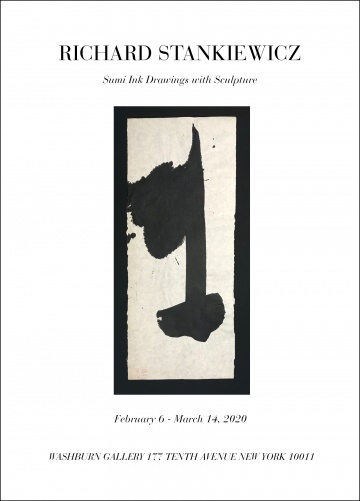
Richard Stankiewicz
Richard Stankiewicz: Sumi Ink drawings with Sculpture
February 5, 2020 - March 14, 2020
This year the Washburn Gallery will be exhibiting works on paper and sculpture by the artist Richard Stankiewicz.. Although known as a sculptor we will install 15 of his sumi ink drawings on Japanese rice paper executed on a single day in November 1960.
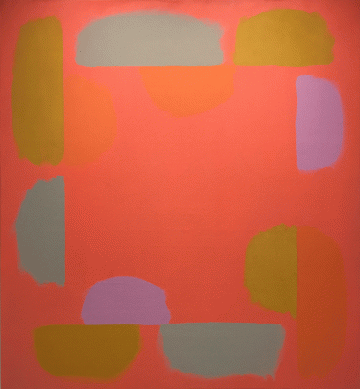
Doug Ohlson
Doug Ohlson: "Poker" Paintings
November 7, 2019 - January 18, 2020
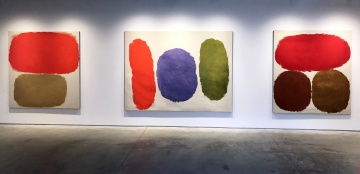
Ray Parker
September 12, 2019 - November 2, 2019

William Baziotes, Ilya Bolotowsky, Michael Goldberg, Reuben Kadish, Elaine de Kooning, Conrad Marca-Relli, Alice Trumbull Mason, Thomas Nozkowski, Doug Ohlson, Ray Parker, Jackson Pollock, Anne Ryan, Charles Green Shaw, Leon Polk Smith, Myron Stout, Jack Youngerman, Jean Xceron
Backroom - Frontroom
June 19, 2019 - September 7, 2019
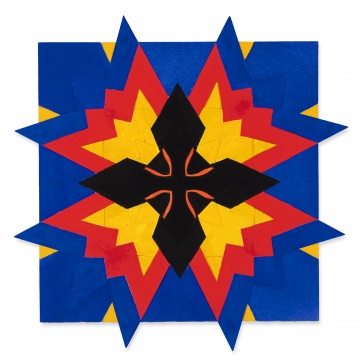
Jack Youngerman
Jack Youngerman: Cut-Ups
April 25, 2019 - May 31, 2019
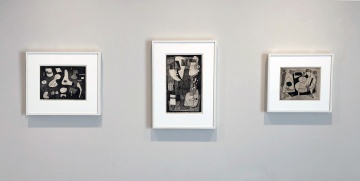
Alice Trumbull Mason
Graphic Works from Atelier 17
March 14, 2019 - April 20, 2019
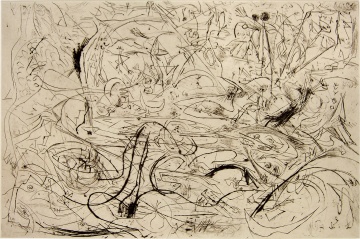
Jackson Pollock
The Graphic Works
January 17, 2019 - March 2, 2019
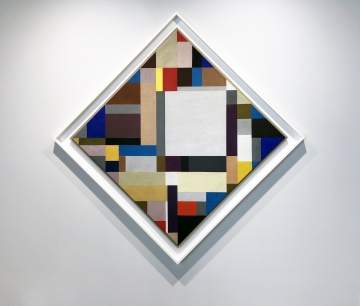
Ilya Bolotowsky
Paintings from 1935-1980
November 1, 2018 - January 12, 2019
Richard Stankiewicz
Sculpture from the 1950s - 1970s
September 13, 2018 - October 27, 2018
Summer Scene
June 11, 2018 - July 27, 2018

Doug Ohlson
The Dark Paintings
April 10, 2018 - June 1, 2018
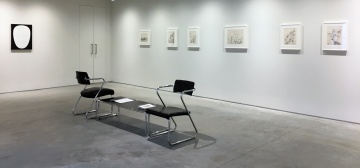
Myron Stout
Landscape Drawings
March 8, 2018 - April 14, 2018
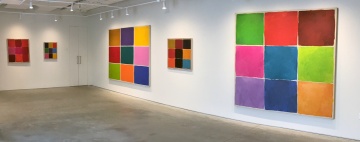
Ray Parker
The Nines
January 11, 2018 - February 24, 2018

 Back to all Member Galleries
Back to all Member Galleries

